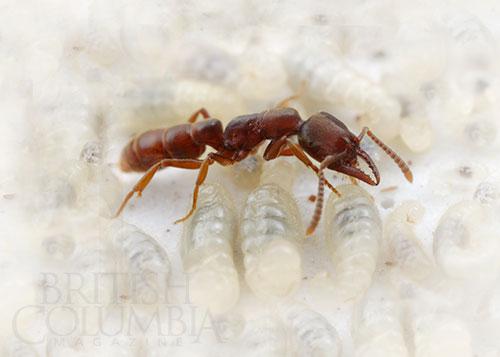Meet a B.C. ant with some surprising eating habits.

There are vampires among us. But unlike the pallid, fang-toothed bloodsuckers made famous by Hollywood, these vampires are easy to overlook.
The Dracula ant (Stigmatomma oregonense)—which in British Columbia is generally found in rotting logs and has been documented in Yale and on Galiano, Cortes, and Pender islands—subsists on the blood of its own larvae. When the queen or workers need to feed, they simply chomp into the exoskeletons of the oldest larvae and drain their hemolymph (insect blood). The larvae typically survive the feedings, explains entomologist Robert Higgins of Thompson Rivers University in Kamloops, though “it’s not something they appear to do voluntarily.” They are often heavily scarred from repeated punctures.
Adult ants in general are unable to eat solid foods because of their restricted waists. In other species, the larvae, which do eat solids, act as a sort of “social stomach,” regurgitating food for the adults to consume. Dracula larvae don’t regurgitate, so the workers and queen rely on this more gruesome means of extracting nutrients.
“[The Dracula ant is] an early offshoot in ant evolution so it has characteristics which are more primitive to ants than other ant species,” explains Higgins. Though there is no evidence, some entomologists suspect that the very first ants were a type of Dracula. They may have maintained their crude habits as other ants evolved.
To sustain their larvae, Dracula ant workers set out from the colony to hunt a specific type of blind centipede. They sting the prey, killing it, and then either drag the centipede back to the nest or, in some cases, transport the larvae to their dinner. Workers often break up the centipede before placing the larvae on top of it to assist with the feeding, much like a human parent cutting a child’s dinner into digestible chunks.
Draculas are rare so if you see one, resist the urge to drive a wooden stake through its body or tackle it with garlic—report the sighting to an entomologist.

